介绍
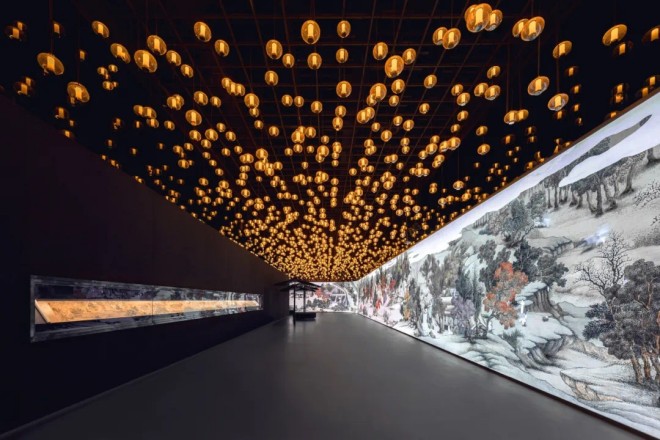
博物馆 博物馆正经历一场科技引领的变革。随着科技的发展,博物馆不仅仅是展示文物,越来越多的博物馆开始“复活”文物。那么如何让文物复活,让游客能够身临其境地去了解呢?
这就需要巨型LED显示屏的助力,南京德基美术馆《金陵图数字艺术展》正是这一波变革中的亮色,为全球博物馆界树立了创新标杆。
1、巨型LED显示屏在博物馆的应用
巨型LED显示屏作为现代科技与传统文化的完美结合,在博物馆中的应用越来越多。
凭借其高 亮度, 高的 解决、高对比度等特点,该类显示屏可以呈现出清晰细腻的图像,给观众带来震撼的视觉效果。在博物馆等公共场所,巨型LED显示屏不仅可以提升展览的观看体验,还可以增强观众的参与感和互动性。
技术特点
1).实时渲染技术
实时渲染技术是巨型LED显示屏在博物馆应用中的一大亮点,通过Unity等先进的图形渲染引擎,博物馆可以实现动态图像的流畅显示。
这些动态图像可以包括历史事件的再现、文物修复过程的演示、虚拟导览等,为观众提供更加丰富多样的展览体验。
2). 3D建模技术
3D建模技术使博物馆能够对展品及其环境进行高精度的三维建模。
该技术不仅能让观众在屏幕上看到展品的三维图像,还能通过旋转、缩放等操作,全方位了解展品的详细特征。
此外,3D建模技术还可以与虚拟现实(VR)技术相结合,为观众提供身临其境的展览体验。
3).定位追踪技术
定位追踪技术在博物馆的应用不容忽视,通过军用级定位系统等技术手段,博物馆可以精准记录参观者的位置和参观路径。
这些数据不仅可以帮助博物馆了解观众的观展习惯和需求,也为后续的展览策划和优化提供有力的支持。
同时,定位追踪技术还可与互动设备结合,实现参观者与展览内容的实时互动。
综上所述,巨型LED显示屏在博物馆的应用,不仅提升了展览的视觉效果和互动性,也为博物馆的数字化转型、智能化升级提供了有力的支持。
2、金陵地图数字艺术展LED显示屏沉浸式体验
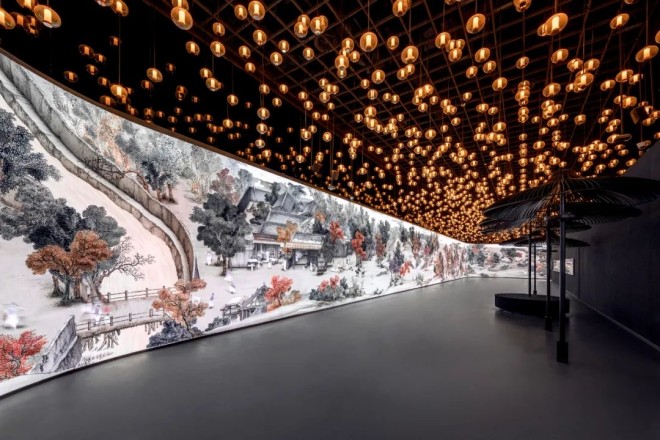
1). 展览 背景和目的
金陵图数字艺术展取材于清代画家冯宁的巨作《金陵图》。
旨在借助现代科技的力量,把观众带入千年前的南京城,体验宋代的文化精髓和生活方式。
展览的核心是通过数字技术的创新运用,让这一历史画卷获得新的生命,成为连接过去与现在的文化桥梁。
1).LED显示屏沉浸式构建
- 环形巨幕:历史画卷的现代诠释
此次展览的核心亮点之一,是长达110米、高3.6米的环形巨型LED屏幕,它不仅将《金陵地图》放大百倍,更以环绕式的视觉设计,将观众带入千年前的金陵景象。
巨幅屏幕上,每一笔都栩栩如生、细腻无比,仿佛历史在眼前缓缓展开,让观众瞬间穿越时空,感受那段辉煌的历史。
- 互动展览:科技与艺术的深度融合
金陵图数字艺术展的创新之处在于其“画中人,实时跟随”的互动模式。
借助先进的数字激活技术,观众的身影可实时投射到屏幕上,与宋代人物并肩而行,甚至参与画中场景,体验一场跨越时空的对话。
这种前所未有的互动体验不仅加深了观众对宋代文化的了解,也使展览本身成为一次独特的文化探险。
2).浸没强化辅助技术
- 动作捕捉:精准互动,沉浸感十足
动作捕捉技术的运用,让观众的每一个细微动作都能被精准捕捉,并实时反馈到屏幕上。
这一技术的引入,不仅提高了互动的流畅度和真实感,也让观众在参与的过程中感受到自己成为了展览的一部分,与艺术品产生了前所未有的联结。
- 次世代3D音效:沉浸式听觉之旅
为了营造全方位的沉浸式体验,金陵图数字艺术展还采用了次世代3D音效技术,该技术通过精准的声音定位和模拟,让观众仿佛置身于真实的宋代集市之中。
无论是街头的喧嚣,还是小巷的宁静,都能被耳朵清晰地感知到,进一步增强了展览的沉浸感和真实感。
金陵图数字艺术展通过LED显示屏的创新应用以及动作捕捉、三维音效等辅助技术的巧妙融合,成功创造了前所未有的沉浸式文化体验。
此次展览不仅是对宋代文化的一次深入探索,更是现代科技与传统艺术完美结合的典范,引领了博物馆展览的新潮流。
3、巨型LED显示屏打造沉浸式博物馆的策略是什么?
巨型LED显示屏在打造沉浸式博物馆中起着至关重要的作用。以下是通过巨型LED显示屏打造沉浸式博物馆的具体策略:
1). 场景设计
- 多元化展示空间
利用巨型LED显示屏设计圆形、五面体、360度环绕等展示空间,这些设计可以增强观众的沉浸感,让观众仿佛置身于一个由LED屏幕构建的全新虚拟世界。
结合投影技术,通过光影效果吸引观众。投影技术可以与LED显示屏相辅相成,创造出更加逼真、生动的场景效果。
- 灵活的布局和创意的设计
根据展览会的主题和展示内容,选择合适的LED显示屏类型和布局。
例如,对于需要高清显示的展品,您可以选择 小间距LED显示屏 具有较高的像素密度;对于需要大面积投影的环境效果,可以选择屏幕尺寸较大的LED显示屏。
设计过程中注重创意元素的融入,独特的造型、色彩搭配、光影效果营造出与展览主题相契合的氛围,让观众在视觉和精神上都得到身临其境的体验。
2)。互动体验
- 设计交互方法
通过手势识别、手机体感等技术,设计观众与屏幕内容的互动方式。
观众可以通过触摸屏幕、挥动手臂、移动身体等方式操作投影效果,与屏幕上的虚拟世界进行实时互动。
利用传感技术,让走过的人与屏幕内容产生互动。例如,当观众走过某一区域时,屏幕上的虚拟人物或场景会做出相应的反应,增强观众的参与感和沉浸感。
- 增强互动体验
在互动体验中融入趣味性和挑战性的元素,如设置游戏关卡、破解谜题等,激发观众的好奇心和探索欲望。
通过互动体验,观众更加深刻地了解展品背后的历史文化内涵,提升了展览的教育意义和文化价值。
3). 内容制作
- 3D建模与多角度展示
展品3D建模,实现多角度、全方位展示。通过3D建模技术,观众可以在屏幕上看到展品的三维形象,并且通过旋转、缩放等操作,可以充分了解展品的详细特征。
利用巨型LED显示屏的高分辨率、高亮度特点,呈现出细腻逼真的3D效果,让观众仿佛置身于展品之中。
- 高品质动态内容
制作高品质的动态内容,如流动的河流、繁忙的街道等场景效果,这些动态内容不仅可以营造沉浸式的氛围,还可以增强观众的代入感和沉浸感。
将历史元素、文化符号融入动态内容中,让观众在欣赏美景的同时,感受到历史的厚重、文化的魅力。
4. 博物馆巨型LED屏幕的其他案例
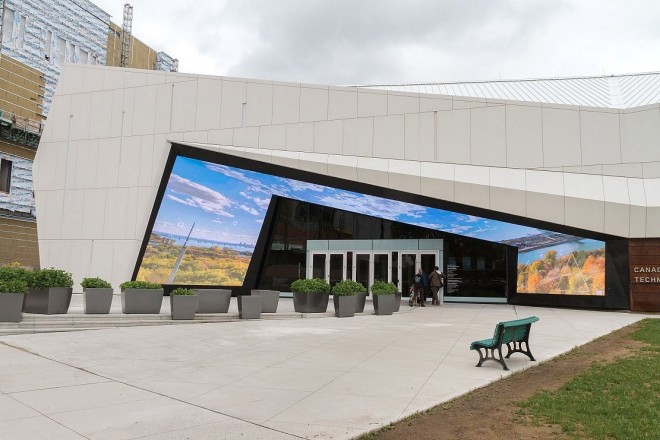
1). 加拿大科技馆
位于渥太华的加拿大科技馆已有50多年的历史,外观科技感十足。
在博物馆内,LED屏幕广泛应用于各个展示场景,为观众提供了丰富多彩的科技体验。
这些屏幕不仅展示了加拿大科技发展的成就,也让观众在互动中感受到科技的魅力。
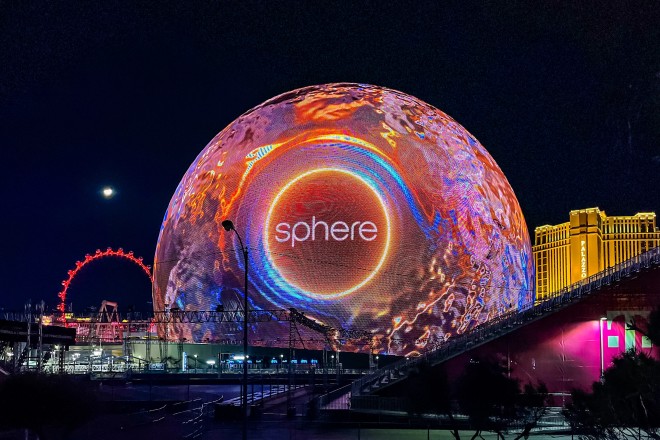
2). 拉斯维加斯的 MSG Sphere
这是一座被称为“全屏”建筑的球形LED屏幕,也是世界上最大的球形建筑和最大的LED屏幕。MSG Sphere直径157米,高111米。里面有17600个座位。
耗时6年打造,耗资23亿美元,里面的LED屏幕面积达15793平方米,分辨率达到16K,显示面积是IMAX的40多倍,此外还有16.4万个扬声器环绕整座建筑,为观众带来一场前所未有的视听盛宴。
MSG Sphere的目标是让观众无需戴眼镜就能享受VR体验,让他们通过触觉、听觉、嗅觉等享受整场演出。
3). 成功经验探讨
- 技术创新
无论哪种情况,都体现了技术创新在博物馆展示中的重要性,通过引入LED显示屏、5G+8K技术、VR等前沿技术,博物馆可以为观众提供更加生动逼真的沉浸式体验。
- 内容丰富
博物馆在运用LED显示屏进行展示时,注重内容的丰富性和多样性,通过展示不同的主题和场景,让观众在观看过程中保持新鲜感和好奇心。
- 互动性强
这些案例都强调了博物馆陈列展示互动性的重要性,通过设计各种互动环节和体验项目,让观众主动参与其中,与展品进行互动、交流,从而增强观众的参与感和沉浸感。
- 注重体验
博物馆在运用LED显示屏进行展示时,十分注重观众的体验,通过优化屏幕布局、调整灯光音效等细节,让观众在舒适的环境中享受身临其境的体验。
5. 博物馆巨型LED显示屏的挑战与未来前景
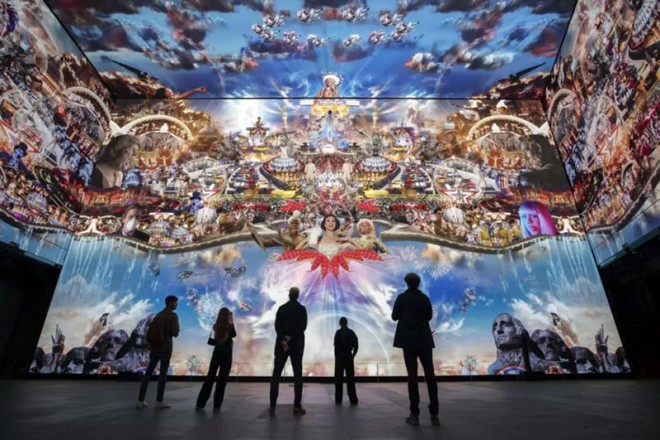
1). 技术挑战
- 成本高昂
巨型LED屏幕的前期投入成本相当高,包括设备采购、安装调试以及后续技术支持的费用,这对很多博物馆来说可能是个不小的负担。
此外,随着技术的不断升级换代,巨型LED屏幕的维护成本也不断增加。
- 技术复杂性
巨型LED屏幕技术复杂度较高,需要专业技术人员进行安装和维护,这就需要博物馆在人才队伍建设上投入更多资源。
同时,由于显示器尺寸巨大,其散热、能耗等问题也需要特别关注。
- 维护难度
巨型LED屏幕维护难度较大,尤其当发生故障时,需要快速响应、修复,这就要求博物馆有完善的维护体系和应急预案。
另外,由于显示屏长期暴露在空气中,很容易受到灰尘、湿气等环境因素的影响,所以需要定期进行清洁和保养。
2). 内容创新
为了持续吸引观众反复参观,博物馆在利用LED巨型屏幕进行展示时,需要注重内容的创新和多样性。具体来说,可以从以下几个方面入手:
- 定期更新展示内容
博物馆可以定期更新展示内容,包括新的展览主题、互动体验项目等,让观众每次参观都能有新的发现和体验。
- 引入多元化展示形式
除了传统的图片、文字、视频展示外,博物馆还可引入AR、VR等新技术,为观众提供更加生动逼真的沉浸式体验。
- 增强互动性
通过设计各类互动环节和体验项目,让观众主动参与其中,与展品互动、交流,从而增强观众的参与感和沉浸感。
- 结合当前热点
博物馆可以结合时事热点、重大事件,策划相关展览、展示活动,吸引观众的关注和参与。
结论
金陵地图数字艺术展的成功举办,不仅让历史文物在科技的羽翼下重生,也让观众在光影的交响中感受到前所未有的文化沉浸感。
展望未来,巨型LED显示屏将会闪耀在更多的博物馆中,不仅为展品注入了新的生命力,也将带领观众进入科技与人文交织的博物馆之旅新时代。
最后,如果您想了解更多关于LED显示屏的知识, 请与我们联系。
